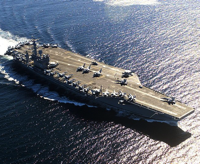Driven in part by a recent article in Proceedings, the magazine of the United States Naval Institute, the debate over the nature and utility of aircraft carriers has once again erupted between naval analysts. In "Twilight of the $uperflous Carrier," Capt. Henry J. Hendrix of the U.S. Navy and retired Lt. Col. J. Noel Williams of the U.S. Marine Corps argue that modern supercarriers are simply too expensive and too vulnerable to be usable weapons of war. They contend that the era of the supercarrier has come to an end, and that the future of naval power resides in warships like the USS America, a big-deck amphibious assault ship that will eventually be capable of operating the F-35B Lightning II VSTOL fighter jet. Bryan McGrath of Information Dissemination disputes several key assumptions of the article, including the relative vulnerability of supercarriers and big amphibious ships, and the role that UAVs will play in the future of carrier aviation.
But while this discussion has thus far been useful and productive, it sidesteps some of the most important ways in which aircraft carriers matter for national defense and national power.
The American debate over the utility of the big carriers is echoed in the United Kingdom and, presumably, in China, where aircraft carrier programs are either resuming or ramping up. The British navy, having decommissioned its last strike carrier, will be without a serious naval aviation capability until the HMS Queen Elizabeth is commissioned near the end of this decade. The British government's lead role in calling for the air campaign in Libya has already caused some to question the wisdom of creating such a gap in British naval air capability and has also reawakened concerns about the design of the Royal Navy's two new carriers. In China, the People's Liberation Army Navy (PLAN) is expected to commission its first aircraft carrier -- Shi Lang, formerly the Ukrainian Varyag -- later this year. Observers continue to debate China's motives and expectations for its carrier aviation program. Pacific Command chief Adm. Robert Willard, for example, has argued that Shi Lang's importance is primarily "symbolic."

